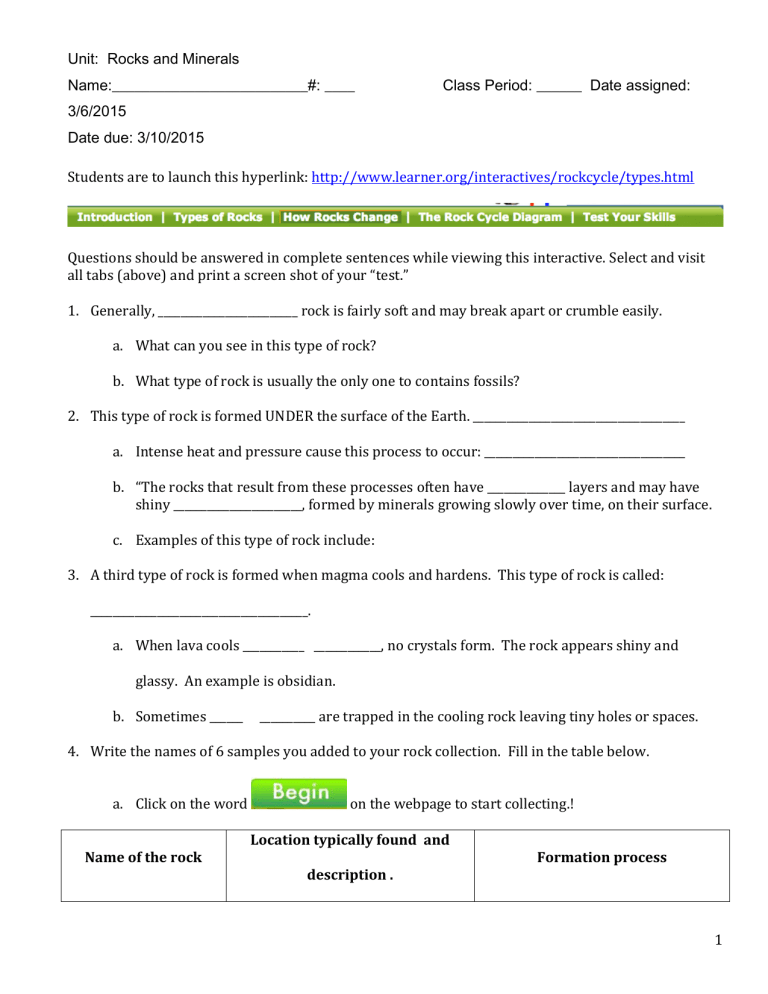Unit: Rocks and Minerals Name: #: ____ Class Period: ______ Date

Unit: Rocks and Minerals
Name:__________________________#: ____ Class Period: ______ Date assigned:
3/6/2015
Date due: 3/10/2015
Students are to launch this hyperlink: http://www.learner.org/interactives/rockcycle/types.html
Questions should be answered in complete sentences while viewing this interactive. Select and visit all tabs (above) and print a screen shot of your “test.”
1.
Generally, _________________________ rock is fairly soft and may break apart or crumble easily. a.
What can you see in this type of rock? b.
What type of rock is usually the only one to contains fossils?
2.
This type of rock is formed UNDER the surface of the Earth. ______________________________________ a.
Intense heat and pressure cause this process to occur: ____________________________________ b.
“The rocks that result from these processes often have ______________ layers and may have shiny _______________________, formed by minerals growing slowly over time, on their surface. c.
Examples of this type of rock include:
3.
A third type of rock is formed when magma cools and hardens. This type of rock is called:
_______________________________________. a.
When lava cools ___________ ____________, no crystals form. The rock appears shiny and glassy. An example is obsidian. b.
Sometimes ______ __________ are trapped in the cooling rock leaving tiny holes or spaces.
4.
Write the names of 6 samples you added to your rock collection. Fill in the table below. a.
Click on the word
Name of the rock
on the webpage to start collecting.!
Location typically found and description .
Formation process
1
Gneiss
Basalt
Mountainsides
Hot lava contains gases that escape during cooling.
Limestone
Found near oceans and lakes and may contain shells
Obsidian
Cools so quickly that no crystals form.
Conglomerate
Marble
River or beach once existed near this rock.
Mountainsides and quarries
5.
a.
The first process described contains two words: _______ and _______________ i.
What analogy was used to describe the process of heat and pressure on rock? Draw a before and after picture based on the description in the interactive. ii.
True/False Rock can change without melting. b.
The second process described is the word used to describe a chocolate bar when it gets very hot: __________________. i.
Explain the difference between the melting and two cooling animations. ii.
What is intrusive igneous rock? Does it cool faster or slower than extrusive igneous rock? c.
Weathering and _______________ form the third process by which rocks can change. i.
4 agents cause weathering or wearing away of rock. Name these.
2
ii.
Which rocks on earth are affected by weathering and erosion? iii.
Watch the animation on Compacting and Cementing. iv.
Watch the animation on weathering and erosion v.
Describe the similarities vi.
What 3 places do sediments build up in? vii.
What causes compaction? Cementation?
6.
viii.
You will have 6 minutes to complete the challenge.
1.
Write down the number of points you scored: _____ a.
Who is attributed with coming up with the concept of the Rock Cycle? When? i.
b.
View every animation c.
Name the three sedimentary rocks. d.
Name the three metamorphic rocks. e.
Name the three igneous rocks. f.
Take the test of your knowledge of the rock cycle. Put your score here: _________
7.
Take the test and print out your results. a.
Tell how many questions you answered correctly: ____________ b.
- print the page that has your assessment results and hand it in with the answers to these questions.
3







